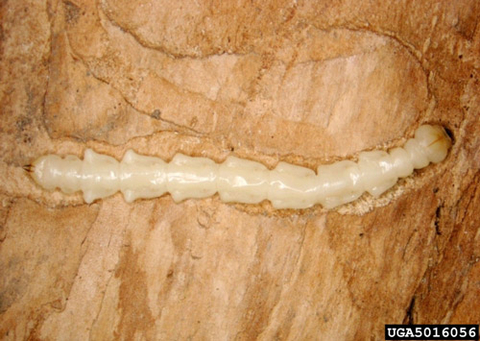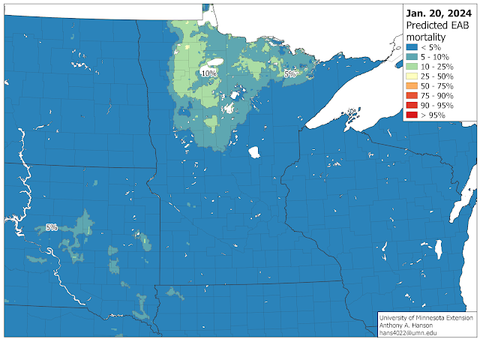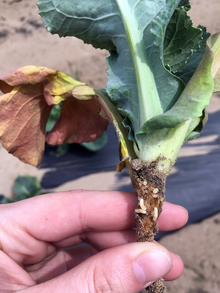After a burst of late snow, spring is finally here. April is predicted to be warm after a winter of record warmth and minimal snow. This will affect this year’s gardening season in many ways.
Many people are wondering how this will impact insects. As always, it depends! Here are some things to think about.
- Each insect species, both beneficial and pest, has a different strategy for riding out the winter.
- While this winter was pretty mild overall, we still had a cold snap in January and got below-zero temperatures many nights.
- We had minimal snow cover but we still had plenty of freeze-thaw cycles.
- We got a burst of snowy weather in March after we had some warm, spring-ish days.
These factors will impact each insect that spends the winter in Minnesota differently.
There was enough cold to kill insects that don’t normally spend the winter here
We likely had enough cold snaps so insects that don’t typically spend the winter in Minnesota weren’t able to survive here. Insects like corn earworm, potato leafhopper and black cutworm were most likely killed during the cold snaps we did have.
How did insects that spend the winter here do? It depends.
When it comes to insects that do spend the winter here, there was enough weirdness this winter that it wasn’t likely stress-free for every pest. What will each pest’s population do this year? Hard to say.
For instance, the Japanese beetle spends the winter as a grub under the soil surface. Research suggests they can survive in soil temperatures down to 27°F. Research in Minnesota looked at winter soil temperatures and Japanese beetle grub survival. The temperatures in the study and the survival rates were:
- 2018-2019 averaged 30.87°F - 36% survival
- 2019-2020 averaged 33.12°F - 77% survival
- 2020-2021 averaged 35.04°F - 100% survival
Soil temperature data is hard to track down. A University of Minnesota weather station in Morris recorded an average soil temp of 31.9°F for a 4-inch soil depth Dec. 1 - Feb. 29 and 27°F for a low soil temp. So there was likely some Japanese beetle mortality in Western Minnesota. But the metro area was warmer than Western Minnesota this winter, meaning we likely had less mortality in the Twin Cities region.
Let’s look at another invasive insect — emerald ash borer. This insect spent the winter underneath the bark of ash trees, which gave them a little insulation. Emerald ash borers start to die when they experience temperatures below -22°F, and half of a given population will die around -24.5°F. The trees they are in give them enough insulation that emerald ash borers likely experienced pretty minimal mortality this winter.
Note that the temperatures needed to kill emerald ash borer are very cold– we often only get that cold during polar vortexes! So while there was likely minimal emerald ash borer mortality this winter, we have a lot of winters with minimal emerald ash borer mortality.
For an example of how this warm winter and March weather impacts a good insect, see our article about this winter and bumble bees.
Will pests that do spend the winter here emerge earlier?
Probably, and we can see this reflected in degree day models. A degree day is a unit entomologists use to reflect how an insect is experiencing the weather.
Insects can't make their own heat, so they depend on their environment to give them the warmth they need to develop and grow. Each insect species has a lower temperature at which they become active and grow and a higher temperature where it is too hot to develop and grow.
We do not have to do this math ourselves. The University of Minnesota and the University of Wisconsin’s Vegetable Disease and Insect Forecast Network have degree day maps for common fruit and vegetable insects. These tools can help time preventative measures for common pests.
Let’s see what the models are saying about cabbage maggot. Cabbage maggots are one of our first pests to come out each growing season, as they can develop and become active anytime temperatures are above 43 degrees, and adults will emerge and start laying eggs at 300 degree days. As of April 4, 2024, cabbage maggots are at approximately 58 degree days in Rochester, 60 degree days in the metro, and 9 degree days in Duluth.
Depending on what the weather does and when your brassicas get planted, part of the cabbage maggot flight period may have passed by the time our cole crops are planted.
What do we do about all this during the gardening season?
The best tool is your own observation skills. Take time weekly to look closely at the plants in your garden for issues. The rhythms and patterns of insects you’ve noticed in the past may have shifted or might not hold true this year, so be observant to detect issues early.




